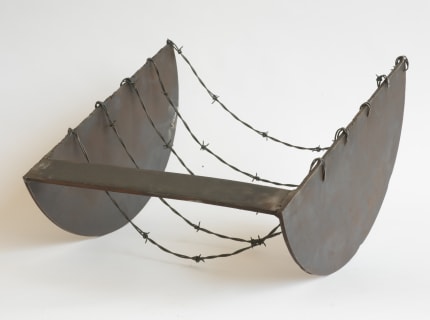Installations are immersive and participatory, and one should feel compelled to engage with the medium of the artwork. However, we are talking about an installation in which you will surely feel emotions but may not feel obligated to completely participate with the medium. Melvin Edwards, a pioneer of contemporary African American art and sculpture, constructed large-scale barbed wire installations in 1970, which were shown for the first time this spring at Dia Beacon in New York. Dia was founded in 1974 with the purpose of serving as a conduit for artists to accomplish ambitious new projects free of overt interpretation and the constraints of more traditional museums and galleries.
The contemporary artist’s work has been the subject of numerous retrospectives and solo exhibitions including those at the Nasher Sculpture Center, Dallas; Neuberger Museum of Art, Purchase, New York; and Whitney Museum of American Art, New York. Edwards was also a professor at the Rutgers University in Newark from 1972 to 2002. In 2014, he received an honorary doctorate from the Massachusetts College of Art and Design, Boston.
The works on display at Dia Beacon represent a period when Edwards—best known for his sculptures of welded steel, chains, and other identifiable metal objects—experimented with various suspension systems to create immersive site-specific sculptures. For these large scale installations, the barbed wire is stretched, pulled, and hung to create massive geometric volumes in space by the contemporary artist. The resulting punctuated metal lines, which are frequently linked with chains, create spatial depth and emphasise the material's “painfully active and strong resistance”, as the artist defines it. While barbed wire has been a source of ongoing fascination for the artist, many of the installations from this period have until now remained as diagrammatic plans.
Edwards explains the gravity of his choice of material that is the barbed wire, “[with] barbed wire, you have to be aware that it was a way to keep the cows at home. But then people turned it into concentration camps. Before it happened with Jewish people in World War II, it happened in Namibia. Those contradictions, or contradistinctions are things that have occupied me in visual art. As a way to realise the dynamic in a situation, art or otherwise.”
Four pieces were recreated for the present, three of which have just entered Dia's permanent collection, and are on exhibit for the first time at the Dia Beacon. An artist, teacher and sculptor, Edwards has employed resonant materials and lyrical names to give formal sculptures political significance throughout his career. He began arranging knives, chains, and other familiar metal things into geometric patterns and abstract compositions after learning to weld in 1960. Edwards relocated to New York in 1967. Around this period, the artist began work on a number of significant public commissions. His work grew in magnitude as he experimented with other suspension methods and materials such as barbed wire and chain.
“I have always understood the brutalist connotations inherent in materials like barbed wire … and my creative thoughts have always anticipated the beauty of utilising that necessary complexity which arises from the use of these materials in what could be called a straight formalist style,” said the artist about his works.
The art exhibition has been on view since May 6, 2022.

